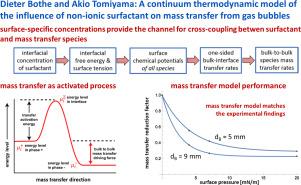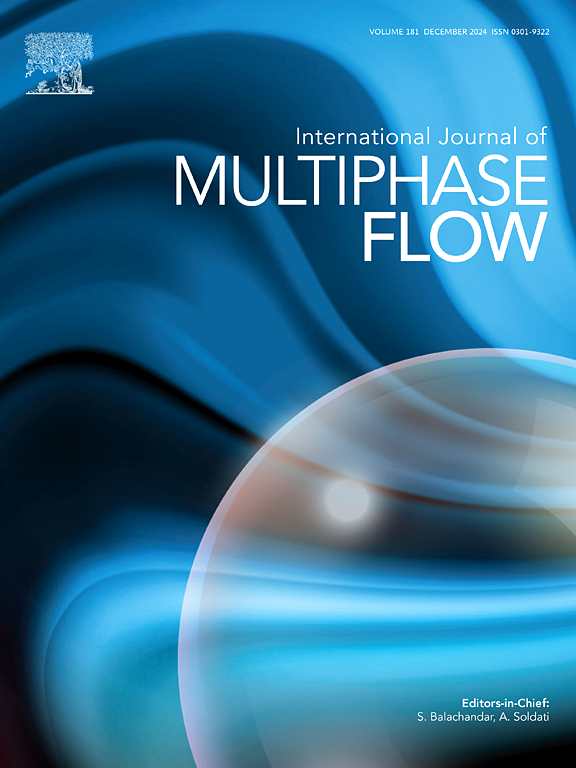A continuum thermodynamic model of the influence of non-ionic surfactant on mass transfer from gas bubbles
IF 3.8
2区 工程技术
Q1 MECHANICS
International Journal of Multiphase Flow
Pub Date : 2025-09-23
DOI:10.1016/j.ijmultiphaseflow.2025.105453
引用次数: 0
Abstract
Mass transfer of gaseous components from rising bubbles to the ambient liquid depends not only on the chemical potential difference of the transfer component but also on the interfacial free energy and composition. The latter is strongly affected by surface active agents that are present in many applications. Surfactants lead to local changes in the interfacial tension, which influence the mass transfer rates in two different ways. On the one hand, inhomogeneous interfacial tension leads to Marangoni stress, which can strongly change the local hydrodynamics, thus impacting the local mass transfer. On the other hand, the coverage by surfactant molecules results in a mass transfer resistance. This hindrance effect is not included in current continuum physical models. The present work provides the experimental validation of a recently introduced extended sharp-interface model for two-phase flows with mass transfer that also accounts for the mass transfer hindrance due to adsorbed surfactant. The crucial feature is to account for area-specific concentrations not only of adsorbed constituents but also of transfer species, and to model mass transfer as a series of two bi-directional sorption-type bulk-interface exchange processes. The resulting model is shown to quantitatively describe experimental measurements on mass transfer reduction for the dissolution of CO bubbles in different surfactant solutions.

非离子表面活性剂对气泡传质影响的连续统热力学模型
气体组分从上升气泡向周围液体的传质不仅取决于传递组分的化学位差,还取决于界面自由能和组成。后者受到许多应用中存在的表面活性剂的强烈影响。表面活性剂导致界面张力的局部变化,从而以两种不同的方式影响传质速率。一方面,不均匀的界面张力导致了马兰戈尼应力的产生,从而强烈地改变了局部的流体力学,从而影响了局部的传质。另一方面,表面活性剂分子的覆盖导致传质阻力。目前的连续介质物理模型不包括这种阻碍效应。目前的工作为最近引入的具有传质的两相流扩展的锐界面模型提供了实验验证,该模型也考虑了由于吸附表面活性剂引起的传质障碍。该方法的关键特征是不仅考虑了吸附组分的区域特定浓度,而且考虑了转移物质的区域特定浓度,并将传质建模为一系列双向吸附型体界面交换过程。所建立的模型可以定量地描述CO2气泡在不同表面活性剂溶液中溶解时传质减少的实验测量结果。
本文章由计算机程序翻译,如有差异,请以英文原文为准。
求助全文
约1分钟内获得全文
求助全文
来源期刊
CiteScore
7.30
自引率
10.50%
发文量
244
审稿时长
4 months
期刊介绍:
The International Journal of Multiphase Flow publishes analytical, numerical and experimental articles of lasting interest. The scope of the journal includes all aspects of mass, momentum and energy exchange phenomena among different phases such as occur in disperse flows, gas–liquid and liquid–liquid flows, flows in porous media, boiling, granular flows and others.
The journal publishes full papers, brief communications and conference announcements.

 求助内容:
求助内容: 应助结果提醒方式:
应助结果提醒方式:


